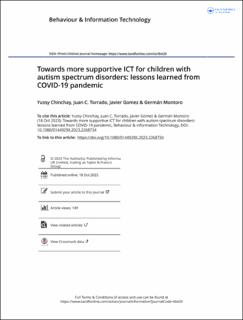Towards more supportive ICT for children with autism spectrum disorders: lessons learned from COVID-19 pandemic
| dc.contributor.author | Chinchay, Yussy | |
| dc.contributor.author | Torrado Vidal, Juan Carlos | |
| dc.contributor.author | Gomez, Javier | |
| dc.contributor.author | Montoro, Germán | |
| dc.date.accessioned | 2023-10-31T08:04:01Z | |
| dc.date.available | 2023-10-31T08:04:01Z | |
| dc.date.created | 2023-10-30T08:58:01Z | |
| dc.date.issued | 2023 | |
| dc.identifier.citation | Behaviour and Information Technology. 2023, . | en_US |
| dc.identifier.issn | 0144-929X | |
| dc.identifier.uri | https://hdl.handle.net/11250/3099601 | |
| dc.description.abstract | COVID-19 pandemic has disrupted daily routines, causing isolation and quarantine. Technology has emerged as a crucial tool for sustaining essential activities, but children with autism spectrum disorders have faced distinct challenges due to their intricate interaction with it. We employed an online survey to analyse the impact of technology use in online learning, remote assistance and daily life of children with autism along COVID-19, and we have identified benefits and challenges with assistive technology exposed by the pandemic. Findings are divided in (1) seven themes where COVID-19 impacted this population the most and their relationship with technology (remote communication, learning, emotional management, entertainment management, executive functions, activities of daily living, and physical activity and motor skills), and (2) a mapping of technological categories that define the working areas specifically aimed to cover the special needs of children with autism whenever face-to-face interactions are not possible (attention, authoring tools, calculation, e-learning, emotions, entertainment, experience of self, language and communication, memory, planning and time management, social networking, and social skills). These results help provide a more well-rounded knowledge of how to improve technology to make it accessible to autistic children, to handle and avoid services interruption in similar scenarios. | en_US |
| dc.language.iso | eng | en_US |
| dc.rights | Navngivelse-Ikkekommersiell-DelPåSammeVilkår 4.0 Internasjonal | * |
| dc.rights.uri | http://creativecommons.org/licenses/by-nc-sa/4.0/deed.no | * |
| dc.title | Towards more supportive ICT for children with autism spectrum disorders: lessons learned from COVID-19 pandemic | en_US |
| dc.title.alternative | Towards more supportive ICT for children with autism spectrum disorders: lessons learned from COVID-19 pandemic | en_US |
| dc.type | Peer reviewed | en_US |
| dc.type | Journal article | en_US |
| dc.description.version | publishedVersion | en_US |
| cristin.ispublished | true | |
| cristin.fulltext | original | |
| cristin.qualitycode | 1 | |
| dc.identifier.doi | https://doi.org/10.1080/0144929X.2023.2268734 | |
| dc.identifier.cristin | 2189737 | |
| dc.source.journal | Behaviour and Information Technology | en_US |
| dc.source.pagenumber | 20 | en_US |
Tilhørende fil(er)
Denne innførselen finnes i følgende samling(er)
-
Publikasjoner fra Cristin [288]
-
Vitenskapelige tidsskriftartikler og konferanseartikler med fagfellevurdering (NVI-kategori) [219]
Vitenskapelige tidsskriftartikler og konferanseartikler med fagfellevurdering (NVI-kategori)

